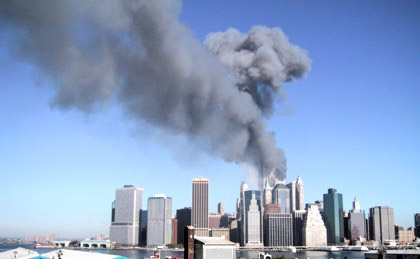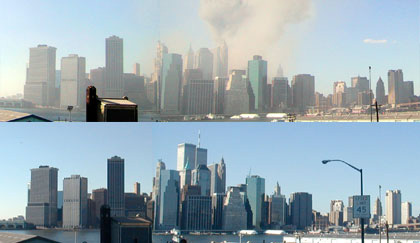The World Trade Center towers were an icon of the most powerful city in the world. Was it a mistake to build these grand towers? No. Architecture captures the strength and power of the American idea.
 September 11, 2001: I stood, stunned, as I watched the TV news on Tuesday. Smoke poured from the first tower of the World Trade Center in the early reports. "They" flew a jet plane through the second tower with a burst of flames! Then the spires of the buildings fell into the smoke.
September 11, 2001: I stood, stunned, as I watched the TV news on Tuesday. Smoke poured from the first tower of the World Trade Center in the early reports. "They" flew a jet plane through the second tower with a burst of flames! Then the spires of the buildings fell into the smoke.
The tallest World Trade Center towers collapsed. First one, then the other. I can't imagine the horror of the end of the people, of the buildings. Not that the buildings were so big and valuable, but they were a symbol of New York City and thus the United States and our lives and beliefs. And they were full of people.

A handful of righteous men have killed thousands. The World Trade Center took over four years and the work of thousands of architects, engineers and skilled journeymen to construct and knit into the fabric of New York City from 1969 to 1973 -- and rebuild in 1993. They rose over a thousand feet from the subway tunnels below ground into the clear, late summer sky over the southern end of Manhattan. Gone in just a couple of hours -- that these men were able to commandeer our daily technology of air flight to commit this devastation is even more frustrating.
Those towers were not the prettiest buildings in the world, but they were an icon of "the most powerful city in the world." We created a powerful target.
This act of men is not an act of Nature or God. It is one thing for a building or a town to be ruined by a flood or an earthquake. We seek meaning in an act of God and Nature as we have for generations. Was it a consequence of our pride, or folly? Perhaps we, the builders, find humility then. An act of vengeful men, offers up just the hatred and fear and pride of the terrorists. Now we fear our complacency and our reaction. What can you build from your fear? It cannot be pretty.
Was it a mistake to build these grand towers? No. These men could have picked any number of great works by Americans -- the Brooklyn Bridge, the Golden Gate Bridge, the Sears Tower. Part of the glory of America over the last 100 years is our success in creating fantastic buildings and bridges. We did it first and better, before anyone else. Today, the tallest buildings in the world are the Petronas Towers in Kuala Lumpur, Malaysia. There are a point of great pride in Malaysia, but they can't capture the imagination of the world as these symbols of America do.

Crashing a plane into one side of the sprawling Pentagon seems almost an afterthought in comparison. But that building holds more import to foreigners perhaps than to us today. God save the pilot who flew his plane into the ground in southern Pennsylvania. What a choice he had to make!
Architecture captures the strength and power of the American idea. These structures are both the response to the needs of our enterprise and a celebration of our success. That makes them all the more attractive as targets to vent the anger and frustration of men who believe the United States and the world have beaten them down and passed them by.
The destruction of Washington by the British taught us painful lessons at the beginning of the 19th Century. The wholesale demolition of buildings and cities in Europe in World War II led us to believe in modern alternatives to our historic ways of building cities, railways and highways. The last plane crash into the Empire State Building in 1945 was clearly an accident then, and we learned the weaknesses and strengths of our building technology in the years that followed -- which led to the even taller towers we have today. The bombing of one of the World Trade Center towers in 1993 taught us new lessons. Then the bombing of the Alfred P. Murrah building in Oklahoma City taught us yet different lessons -- some of which are embodied in the new Steven Schiff Federal Courthouse in downtown Albuquerque, for example.
As the dust settles and daily lives are rebuilt, we will discover the lessons of this disaster. The strength of the United States is not just the strengths of its buildings and icons, but our skill to learn and build again. The citizens of New York City and Washington have re-invented and reconstructed their lives and buildings several times in the face of tragedy. We will learn and build again with our faith in the future.
What do you think? Post your comments below.
John Hooker writes a monthly column on architecture and urban design for The Albuquerque Tribune. A version of this column was published there on September 13, 2001. Hooker serves as Mayor of the Village of Los Ranchos de Albuquerque, a rural-residential suburb of five square miles and 5,000 residents in the Rio Grande Valley just north of Albuquerque, New Mexico. Hooker continues his career as an architect and construction manager. He is a past president of the Albuquerque chapter of the American Institute of Architects and an active member of the Congress for the New Urbanism and 1000 Friends of New Mexico.

Planetizen Federal Action Tracker
A weekly monitor of how Trump’s orders and actions are impacting planners and planning in America.

Chicago’s Ghost Rails
Just beneath the surface of the modern city lie the remnants of its expansive early 20th-century streetcar system.

Amtrak Cutting Jobs, Funding to High-Speed Rail
The agency plans to cut 10 percent of its workforce and has confirmed it will not fund new high-speed rail projects.

Ohio Forces Data Centers to Prepay for Power
Utilities are calling on states to hold data center operators responsible for new energy demands to prevent leaving consumers on the hook for their bills.

MARTA CEO Steps Down Amid Citizenship Concerns
MARTA’s board announced Thursday that its chief, who is from Canada, is resigning due to questions about his immigration status.

Silicon Valley ‘Bike Superhighway’ Awarded $14M State Grant
A Caltrans grant brings the 10-mile Central Bikeway project connecting Santa Clara and East San Jose closer to fruition.
Urban Design for Planners 1: Software Tools
This six-course series explores essential urban design concepts using open source software and equips planners with the tools they need to participate fully in the urban design process.
Planning for Universal Design
Learn the tools for implementing Universal Design in planning regulations.
Caltrans
City of Fort Worth
Mpact (founded as Rail~Volution)
City of Camden Redevelopment Agency
City of Astoria
City of Portland
City of Laramie


























